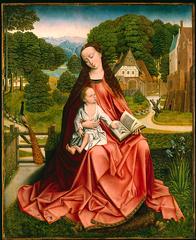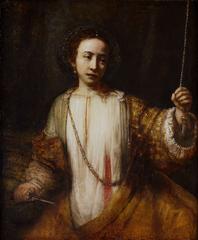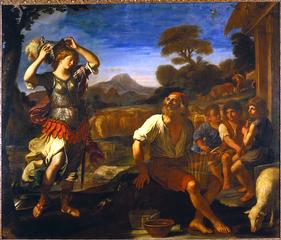|
|
 |
Context - History
1400s - Invention of oil paints
Prior to the 1400s, the primary medium for most paintings was tempera. Tempera is a quick-drying paint made of finely ground pigments mixed with diluted egg yolks. It is a restrictive medium, because the paint is opaque, blending colors is hard, and three-dimensional effects are difficult to create. However, artists in Flanders, primarily Jan and Hubert Van Eyck and The Master of Flémalle, began mixing pigments with drying oils such as walnut or linseed. Oils allowed for a wider range of colors and modulation and could be applied in thin, "glowing" layers. Since oil is a slow-drying medium, artists can easily manipulate the paints and make changes.
This altarpiece by the Flemish painter, The Master of the Embroidered Foliage, is a fine example of an early oil painting on panel.
 Master of the Embroidered Foliage
Master of the Embroidered Foliage
Virgin and Child in a Landscape
c.1495-1500
Oil on panel
|
1480-1600 - High Renaissance
The Renaissance is a period in Europe between the 14th and 16th centuries, and is defined as the humanistic revival in art, literature and learning. This period is often considered the beginnings of the modern age, witnessing the rise of scientific inquiry and world exploration. The art of this period recalls the classical cultures of Greece and Rome. The Renaissance emphasized the individual, and painters depicted humans as naturalistically as possible.
Major artists of the High Renaissance were Leonardo da Vinci, Michelangelo, Raphael and Titian. These artists represent the mature period of the Renaissance, whose work represents the artistic discoveries of compositional aspects such as of balance, and perspective.
1517 - The Reformation
The Reformation began as a political, religious, and social revolt against papal authority. Many people felt the Roman Catholic Church was abandoning its values. In 1517, Martin Luther, one of the leaders of the Reformation, ignited the rebellion when he posted on the door of his church in Wittenburg the 95 Theses, a treatise against the corruption of the Roman Catholic Church. Protestant reformers did not believe in religious painting and elaborately painted churches; they believed these objects were worshiped more than God, himself. |
c. 1530 - Titian, The Temptation of Christ
The Baroque artist Titian was well known for his compositions and energetic brushstrokes. The Temptation of Christ shows the keen sense of color used by the Venetian Baroque artists. Castiglione was greatly influenced by the works of Titian, and may have seen woodblock prints of Titian's famous Assumption of 1518, while he was painting The Immaculate Conception.
 Titian (Tiziano Vecelli) Titian (Tiziano Vecelli)
The Temptation of Christ
c. 1525-1530
Oil on panel
|
1545 - The Counter-Reformation
The Counter-Reformation (see The Reformation,1517) was the Roman Catholic Church's attempt to win back its faithful. Unlike the Protestant reformers, however, the Catholic Church promoted the veneration of the saints, and strove to create even more ornate churches. The art in the churches was intended to illustrate Bible stories and the doctrines of the Catholic Church. This theatrical and passionate art created an emotional connection to the worshipers in an effort to involve them in their faith. During the Counter-Reformation, veneration of the Virgin Mary, Mother of Jesus Christ, flourished among the Catholic faithful. This stimulated renewed interest in the doctrine of the Immaculate Conception, especially in Spain.
1600-1700 - Baroque Art
Baroque art, featuring passionate and theatrical compositions, is dynamic and colorful, surging with emotion. The Church of the Counter-Reformation in Italy used the emotional intensity of the Baroque style to bring the lapsed faithful back to the church.
c. 1642 - Pietro da Cortona, Portrait of Cardinal Pietro Maria Borghese
Pietro da Cortona painted this portrait of Cardinal Pietro Maria Borghese while he was living in Rome. Cardinal Verospi, Bishop of Osimo, who had work obligations in Rome, may have seen this painting or other works by Pietro da Cortona.
 Pietro da Cortona (Pietro Berrettini) Pietro da Cortona (Pietro Berrettini)
Portrait of Cardinal Pietro Maria Borghese
c. 1525-1530
Oil on panel
|
Pietro da Cortona was originally commissioned to paint The Immaculate Conception for the church at Osimo. Cardinal Verospi hired Pietro da Cortona and gave him a down payment to begin work. However, for reasons unknown, da Cortona later declined the commission and returned the down payment. It was then that Cardinal Verospi hired Castiglione to paint the altarpiece of The Immaculate Conception for the church.
1648 - Church at Osimo built
On June 20, 1648, the Bishop of Osimo, Cardinal Girolamo Verospi, laid the cornerstone for the construction of a church for the Capuchin monastery in Osimo, replacing an older church dedicated to Saints Helen and Dionysius. As stated in the inscription on the cornerstone, this new church was to be dedicated to The Immaculate Conception. Only a year later, Pier Filippo Fiorenzi, the archdeacon of the new church, commissioned an altarpiece, illustrating the theme of The Immaculate Conception. Even though the Fiorenzi family built the church and paid for the altarpiece, Cardinal Verospi acted as liaison between painter and patron in Rome.
 What the interior of the Church at Osimo may have looked like. What the interior of the Church at Osimo may have looked like.
|
1666 - Rembrandt, Lucretia
Lucretia was painted in the last years of Rembrandt's life and is one of the masterpieces of this Dutch Baroque artist. Rembrandt's earlier etchings, had a profound effect on Castiglione. Castiglione greatly admired the way Rembrandt used line and shading, or chiaroscuro, in his prints.
 Rembrandt Harmensz van Rijn Rembrandt Harmensz van Rijn
Lucretia
1666
Oil on canvas
|
1804-1814 - Church at Osimo dismantled
The takeover of Italy during the reign of Napoleon I closed many monasteries, and their goods and artworks were confiscated by Napoleonic forces. The Capuchin church in Osimo suffered this fate.
Early 1800s - Painting reclaimed by family and possibly restored
Shortly after the Church in Osimo was dismantled, The Immaculate Conception was reclaimed by the Fiorenzi family and may have been restored at this time. The family retained possession of the painting until shortly before it was purchased by The Minneapolis Institute of Arts in 1966. An article in The Minneapolis Institute of Arts Bulletin reported the painting was hanging in a narrow staircase in the Archivio Fiorenzi as late as 1955.
1500s - Linen used as painting support
The immense size of the Castiglione painting is made possible by the canvas support. Prior to the 1500s most paintings were made on wooden panels. It was first used in Flanders as early as the 1400s, and slowly worked its way south to Italy. Wooden panels had to be quite thick to prevent warping, and were very expensive due to the limited availability of old-growth timber in Europe. Lightweight canvas also made paintings easier to move over long distances. This is the case of Castiglione's The Immaculate Conception, which was moved from Rome to Osimo.
Erminia and the Shepherds is another example of a large-scale 17th-century painting in the collection of The Minneapolis Institute of Arts.
 Il Guercino (Giovanni Francesco Barbieri) Il Guercino (Giovanni Francesco Barbieri)
Erminia and the Shepherds
1649
Oil on canvas
|
 |
